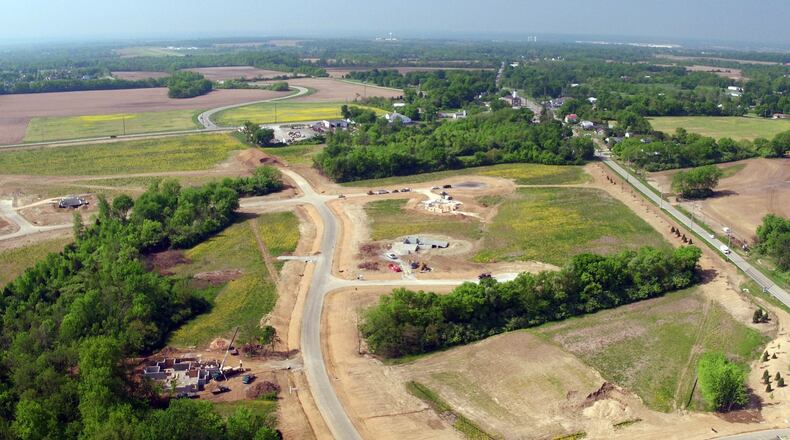“If Dayton is not seeing either of those two things (jobs and population), you are not going to see new homes being built,” Dayton home builder Charles Simms said.
“Charlie is exactly right,” said Mike Dungan, co-owner of Beavercreek’s J.M. Dungan Custom Homes. “We’re not experiencing growth. In fact, we’re losing the population.”
Permits down
Permits for new homes tell part of the local story: Combining single family, apartment and condominiums, a total of 203 residential new building permits were issued for March — which is down 23.4 percent from last year at the same time.
In 2018, building permits are down 19 percent compared to the same time period last year. The total number of permits for the year to date is 556, down from 683 in 2017 but up from 512 in 2016, according to Home Builders Association of Dayton numbers.
MORE: New owner of downtown Dayton building promises to bring apartments 'back to life'
In Butler and Warren counties, which have been the top producers of new homes in Ohio for the past decade, permit numbers are also down compared to 2017.
Year to date as of March, permits for single-family detached homes in Butler County fell 37.5 percent in 2018 (105 permits) compared to the same point in 2017 (168 permits), according to the Cincinnati Home Builders Association. (Permits pulled in Hamilton and Clermont counties are up for the year compared to 2017.)
In Warren County, the 286 permits pulled for single-family homes as of March this year represent a 17 percent drop compared to the 345 permits pulled by this point in 2017, also according to the Cincinnati association.
MORE: Nearly 550 people join class-action lawsuit against this Miami Valley manufacturer
Warren County is usually the strongest Cincinnati-area county in the building of homes, said Dan Dressman, executive director of the Home Builders Association of Greater Cincinnati. People are moving there, and land is available for lots.
“Warren is typically the leader in overall permits,” he said.
Stagnant population
Population drives home building, builders say.
“You’re seeing fewer new communities, which means fewer lots, which means fewer houses being built,” Simms added.
Overall, population estimates released last spring show the nine-county Dayton region barely grew by .2 percent from 2015 to 2016. Several local cities showed percentage drops, including Cedarville (-1 percent), Greenville and Sidney (-.8 percent), Oakwood (-.4 percent) and Kettering (-.3 percent).
Dayton itself has been stagnant, if falling slightly, again according to estimates. The city’s population in the spring of 2016 was put at 140,489, down slightly from 141,869, which itself was down well below the 203,371 residents Dayton once had in 1980.
MORE: Sports betting in Ohio? Bet on it
The nation as a whole isn’t growing explosively, but home permits overall are up.
The U.S. population today is more than 327 million, growing at a pace of about .07 percent a year. Nationally, privately-owned homes authorized by building permits in April were at a seasonally adjusted annual rate of 1,352,000, according to the federal government. That’s a 1.8 percent below the March 2018 rate of 1,377,000 — but more than 7 percent higher than the April 2017 rate of 1,255,000 units.
Kathleen Unger, executive director of the Home Builders Association of Dayton, said the harsher-than-expected winter slowed building or halted new builds, but the initial permit data received from local counties and municipalities from April looks promising.
“Let’s see how the next month or two fare and then we can evaluate from the actual data of the first two quarters,” Unger said in an email.
MORE: Sears may sell this legendary brand
Cincinnati’s Dressman said the Queen City’s biggest hurdle is lack of lots.
“Our situation is somewhat different,” he said. “There are just not a lot of available lots for houses to be built on. Lots are scarce right now.”
In addition, construction labor is tight. “There’s not enough labor to get the work completed, to meet the demand,” Dressman said.
Simms agrees that the most recent winter was a cold one, and that’s one reason for the drop in permits.
But the bigger picture is population, jobs and higher development costs, he and Dungan said. “Development costs are gone up, and you’re seeing less developed lots on the market,” Simms said.
Even more than a decade after the Great Recession, lenders can be wary of getting involved in real estate, to some degree.
“Lenders have still not come back from the crash, from the Great Recession,” Simms said.
Richard Stock, a University of Dayton researcher, recently said the Dayton area has gained about 25,600 jobs in the past four years and 9,900 jobs in the past year alone.
But Dayton metro area lost about 34,800 jobs between March 2007 and March 2010, Stock noted. And wages have sunk. Wages in Dayton have declined from $918 in average weekly earnings in 2007 to $744 in 2017, he said.
“The jobs lost in this area have been tremendous,” Dungan said.
Lumber is more expensive
Home building is more expensive these days, Dungan said. A typical lumber framing package for a home is up about $7,000 in the last 18 months.
Suppliers have told builders that forest fires have depleted some of the cutting areas, Dungan said. Rebuilding in hurricane-ravaged areas is drawing more lumber, draining supply to others areas.
Another factor: Tariffs on lumber imports from Canada are driving prices up, Dungan said.
Development costs can be significant, agreed Bob Morrison, 2018 president of Dayton Realtors. “I’m sure that can eat their lunch for them.”
But the lack of new homes drives a problem that seems to feed on itself, he said. Without new homes, homeowners may be reluctant to sell for fear of not having another home to buy.
“People don’t put their homes on the market because they don’t have some place to go,” Morrison said. “One thing rolls into another. It’s really a tumultuous time right now.”
One route around the problem is “in-fill” development — building new homes in areas where crucial and expensive infrastructure is already in place, such as established urban areas, Simms said.
“As opposed to sprawling out, (building) major roads out in the country,” Simms said. Long-term, cities may see more in-fill in areas where infrastructure is already in place.
The strongest market in the Dayton area in Dungan’s view is Beavercreek, driven by jobs in and around Wright-Patterson Air Force Base, which remains Ohio’s largest single-site employer with more than 27,000 employees. He said his firm, J.M. Dungan Custom Homes, has increased sales over last year or so.
Even in relatively tough times, one sector that is showing promise is smaller single-floor, single-family homes, Dungan said. Retirees often sell the larger homes in which they raised families and are buying smaller, more liveable homes.
By the numbers
556: 2018 Dayton-area home permits pulled
683: 2017 Dayton-area home permits pulled by the same point
512: Dayton-area home permits pulled by the same point in 2016
Source: Home Builders Association of Dayton
Cincinnati-area home permits, as of March
Butler County: 105 in 2018; 168 in 2017
Warren County: 286 in 2018; 345 in 2017
Hamilton County: 145 in 2018; 115 in 2017
Clermont County: 118 in 2018; 95 in 2017.
Source: Home Builders Association of Greater Cincinnati
About the Author

